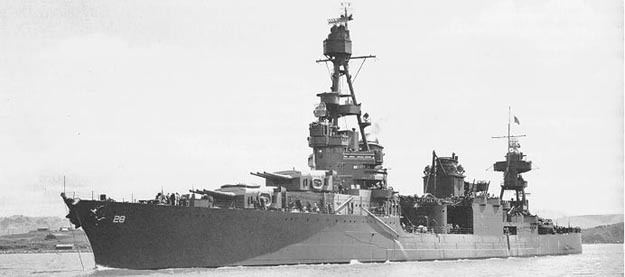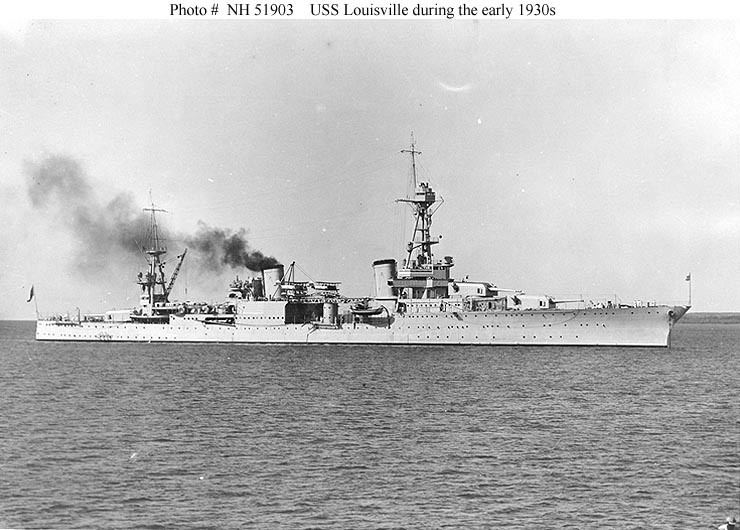Name Louisville Laid down 4 July 1928 Construction started 4 July 1928 Beam 20 m | Ordered 18 December 1924 Length 183 m Launched 1 September 1930 | |
 | ||
Awarded 19 April 192713 June 1927 (supplementary contract) Cost $11,100,000 (limit of cost) Builder Puget Sound Naval Shipyard and Intermediate Maintenance Facility | ||
Suicide attack on uss louisville ca 28 6 january 1945
USS Louisville (CL/CA-28), a Northampton-class cruiser, was the third ship of the United States Navy to be named for the city of Louisville, Kentucky. She was active throughout the Pacific War. USS Louisville was the first large warship to be built in a drydock from Man of War.
Contents
- Suicide attack on uss louisville ca 28 6 january 1945
- Uss louisville ca 28 bombardment of saipan ships off saipan full
- Interwar period
- World War II
- Post war
- Awards
- References

Louisville was launched on 1 September 1930 at the Puget Sound Navy Yard, Bremerton, Washington, sponsored by Miss Jane Brown Kennedy, and commissioned on 15 January 1931, Captain Edward John Marquart in command.

Originally classified as a light cruiser, CL-28, because of her thin armor. Effective 1 July 1931, Louisville was redesignated a heavy cruiser, CA-28, because of her 8-inch guns in accordance with the provisions of the London Naval Treaty of 1930.

Uss louisville ca 28 bombardment of saipan ships off saipan full
Interwar period

Louisville's shakedown cruise, running through the summer, fall, and winter of 1931, took her from Bremerton to New York City via the Panama Canal. Returning from New York, she participated in the 1932 fleet problems before commencing gunnery exercises in the San Pedro-San Diego area. During the winter of 1933, she steamed for Hawaii, returning after exercises to San Pedro where she became a schoolship for anti-aircraft training. In April 1934, the cruiser steamed out of San Diego to begin a nine-month voyage "showing the flag" at various ports in Central America, the Caribbean Sea, and along the gulf and east coasts. Arriving back in California in late fall, Louisville participated in gunnery and tactical exercises until the spring of 1935, when she departed for Dutch Harbor, Alaska, and, thence, to Pearl Harbor to take part in fleet problems.
For the next two years, she operated off the West Coast, participating in the 1936 and 1937 fleet problems, making good will calls at Latin American ports and undergoing local training operations. In January 1938, Louisville began a long Pacific cruise which took her to Hawaii, Samoa, Australia, and Tahiti before returning to Pearl Harbor for fleet problems. While in Sydney, the crew of the Louisville rescued a number of passengers from a sightseeing ferryboat which had capsized when most of the passengers crowded to the rail to wave the cruiser off.
The winter of 1939 found Louisville participating in fleet exercises in the Caribbean. She operated in these waters until May, when she returned to the west coast. After fleet problems off Hawaii that autumn, Louisville departed Long Beach, California for an extended cruise through the Panama Canal to eastern South America. At Bahia, Brazil, she received orders to proceed to Simonstown, South Africa.
As a neutral ship, Louisville traveled the U-boat-infested waters with her American flag spotlighted. At Simonstown, she received $148 million in British gold for deposit in the United States. She then sailed for New York City, delivered her precious cargo and returned to the Pacific.
World War II
On 7 December 1941, Louisville, escorting A. T. Scott and President Coolidge, was en route from Tarakan, East Borneo, to Pearl Harbor. She continued on to Hawaii, stopped briefly to survey the damage and proceeded on to California. There she joined Task Force 17 (TF 17) and steamed from San Diego on 6 January 1942, for Samoa, landing troops there on 22 January. Her first offensive operation of the war came on her return trip when she took part in carrier plane raids on 1–2 February on the Gilbert and Marshall Islands. During this action, she lost one of her planes.
After a short stay at Pearl Harbor, Louisville commenced patrolling the Ellice Islands area to help protect American bases in that vicinity. Early in March she joined TF 119, a carrier force, and began operations to stem the Japanese advancement down the Bismarck Archipelago and the Solomons. This force steamed in the Salamaua-Lae-Rabaul sector for a number of days, making airstrikes on numerous objectives.
Following this operation, Louisville returned to Pearl Harbor, proceeding from there to Mare Island Navy Yard, San Francisco, where her armament was increased. On 31 May, she steamed for the Aleutians to join TF 8. Her duties, during this period of Japan's strongest efforts to establish the northern end of her "ribbon defense" in the western Aleutians, were primarily those of convoy escort, but included shore bombardment of Kiska Island.
On 11 November, the cruiser departed San Francisco for Pearl Harbor, continuing, after a few days on to the South Pacific, escorting several troop transports as far as New Caledonia. She then proceeded north to Espiritu Santo to Join TF 67, which was then battling Japanese forces in the Solomons. On 29 January 1943, Louisville participated In the Battle off Rennell Island, the last of the seven naval battles for Guadalcanal, after which she operated east of the island until it was entirely secured.
In April, Louisville steamed, via Pearl Harbor, to the Aleutians. There, as a unit of TF 16, the cruiser covered the assault and occupation of Attu (11–30 May) and participated In the preinvasion bombardment of Kiska in July.
After the latter was evacuated by the Japanese, she conducted escort of convoy operations in the northern Pacific. In January 1944, Louisville returned to the southern Pacific as the flagship of Rear Admiral J. B. Oldendorf, who was to command the naval gunfire support groups through the amphibious operations ahead. In the Marshalls at the end of the month, she bombarded Wotje Atoll, west of Kwajalein, on 29 January. Then the cruiser turned her guns on the airfield and troop concentrations on Roi and Namur on the southern tip of the atoll, contributing to the conquest of those islands by 3 February. Two weeks later, Louisville led the gunfire support group into action at Eniwetok, which fell on 22 February.
After Eniwetok, Louisville joined TF 58, and with the fast aircraft carriers struck Japanese installations in the Palaus, in March, and bombarded Truk and Sawatan in April. June brought preparations for the invasion of the greater Marianas, and again Louisville was the leading unit in shore bombardment operations; beginning with Saipan, where she fired continuously for the first 11 days of that engagement, through the shelling of Tinian, and ending with the assault on Guam.
After the Mariana Islands, Louisville retired to the rear area until mid-September, when she steamed to the Palaus for the preinvasion bombardment of Peleliu. Then as advanced bases were created, final preparations for the invasion of the Philippines were made. On 18 October, Louisville entered Leyte Gulf and pounded Japanese shore installations.
Louisville became the first large US ship to enter Philippine waters since 12 December 1941. Seven days later, she was in the Battle of Leyte Gulf, participating in the last engagement of a battleline as the Japanese southern force attempted to force its way into Leyte Gulf through Surigao Strait. Admiral Oldendorf deployed the American battleline across the strait and PT boats and destroyers on either side of the narrow body of water, defeating the Japanese ships as they passed through the strait.
During the Battle of Surigao Strait, Louisville helped to sink the bow section of the Japanese battleship Fusō, after the battleship had broke into two from an internal explosion caused by a torpedo from the destroyer USS Melvin.
Following Leyte operations, Louisville rejoined the fast carriers now designated TF 38, and participated in preinvasion strikes against the enemy on Luzon. By the new year, 1945, Louisville was headed towards Lingayen Gulf. While en route on 5–6 January, two kamikazes headed for and scored on her. The first Kamikaze on January 5, 1945 hit the No. 2 main battery 8 inch 55 caliber gun knocking it completely out of commission. The second Kamikaze on January 6, 1945 hit the starboard side signal bridge. Rear Admiral Theodore E. Chandler, commander of Cruiser Division 4 (CruDiv 4) was fatally injured helping the sailors man handle the hoses to put out the massive flames during the latter attack, and died of his wounds the following day. Rear Admiral William P. McCarty (then Commander) took control of Louisville and managed recovery efforts in fighting fires and restoration of equipment, for which he was awarded the Silver Star. Also killed was Admiral's Orderly Walter Joseph Siegel, who was standing by the Admiral at the time. Siegel was the only Marine killed; however, 41 Navy men were also killed. Despite extensive damage, the cruiser shelled the beaches and shot down several enemy planes before withdrawing and proceeding to Mare Island Navy Yard for repairs.
Her repairs completed in the spring, Louisville delivered Admiral Halsey's 50 officers and 100 staff to the battleship Missouri at Guam and Louisville returned to the Pacific to join TF 54 in providing gunfire support for ground forces on Okinawa. On 5 June, she was again hit by a kamikaze(Initially identified as a friendly plane), but was back on the gun line by 9 June, to remain on station until ordered back to Pearl Harbor for repairs on 15 June.
Post-war
With the end of the war on 14 August, Louisville was again seaworthy and hurriedly prepared for postwar duties. On 16 August, she sailed for Guam to Darien, Manchuria, with Rear Admiral T. G. W. Settle on board. From Darien, where the evacuation of Allied POWs was supervised, she steamed to Tsingtao, where Japanese vessels in that area were surrendered by Vice Admiral Kaneko. Louisville then escorted the surrendered vessels to Jinsen, Korea, after which she returned to China for further postwar duties at Chefoo. In mid-October, she joined the Yellow Sea force for abbreviated service before proceeding, via San Pedro, to Philadelphia, where she decommissioned on 17 June 1946 and entered the Atlantic Reserve Fleet. Remaining with that fleet for the next 13 years, Louisville was struck from the Naval Vessel Register on 1 March 1959, and sold on 14 September to the Marlene Blouse Corporation of New York.
Louisville's ship's bell is on display at the Navy Operational Support Center in Louisville, Kentucky. One of her main gun turrets was removed and taken to the Nevada Test Site and converted into a rotating radiation detector, to collect data on nuclear tests.
Awards
Louisville was awarded 13 battle stars for her service during World War II.
